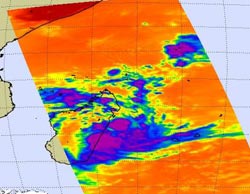Low strengthens into Hubert, making landfall in Madagascar

NASA\'s Aqua satellite captured cold thunderstorm cloud tops of Hubert in this infrared image of March 10 at 5:11 a.m. ET. Hubert\'s western edge is already raining on Madagascar. Credit: NASA JPL, Ed Olsen<br>
The Atmospheric Infrared Sounder (AIRS) instrument on NASA's Aqua satellite captured Tropical Storm Hubert's cold thunderstorm cloud tops on March 10 at 5:11 a.m. ET as the western edge of the storm was already raining on eastern Madagascar.
The infrared imagery showed two areas where convection was strong in Hubert: the northeastern and southern quadrants of the storm. It is in those two areas that the highest, coldest thunderstorm tops were revealed by AIRS infrared imagery. Those thunderstorm cloud tops were as cold as -63 Fahrenheit!
Hubert has maximum sustained winds near 39 mph (35 knots) and is moving west-southwest near 6 mph (5 knots). At 10 a.m. ET (1500 UTC) on March 10, Hubert was located about 160 nautical miles southeast of the capital city of Antananarivo, Madagascar near 20.9 South and 48.8 East.
As Hubert continues moving inland over the next two days, forecasts for the capital city and other areas in south central Madagascar will continue to experience periods of moderate to heavy rainfall, and gusty winds.
Animated multispectral satellite imagery showed a loss of central convection as Hubert's center moves closer to a landfall. Once Hubert's center is over land, forecasters expect Hubert will quickly fall below tropical storm strength.
Media Contact
More Information:
http://www.nasa.govAll latest news from the category: Earth Sciences
Earth Sciences (also referred to as Geosciences), which deals with basic issues surrounding our planet, plays a vital role in the area of energy and raw materials supply.
Earth Sciences comprises subjects such as geology, geography, geological informatics, paleontology, mineralogy, petrography, crystallography, geophysics, geodesy, glaciology, cartography, photogrammetry, meteorology and seismology, early-warning systems, earthquake research and polar research.
Newest articles

Sea slugs inspire highly stretchable biomedical sensor
USC Viterbi School of Engineering researcher Hangbo Zhao presents findings on highly stretchable and customizable microneedles for application in fields including neuroscience, tissue engineering, and wearable bioelectronics. The revolution in…

Twisting and binding matter waves with photons in a cavity
Precisely measuring the energy states of individual atoms has been a historical challenge for physicists due to atomic recoil. When an atom interacts with a photon, the atom “recoils” in…

Nanotubes, nanoparticles, and antibodies detect tiny amounts of fentanyl
New sensor is six orders of magnitude more sensitive than the next best thing. A research team at Pitt led by Alexander Star, a chemistry professor in the Kenneth P. Dietrich…





















